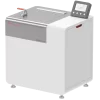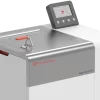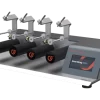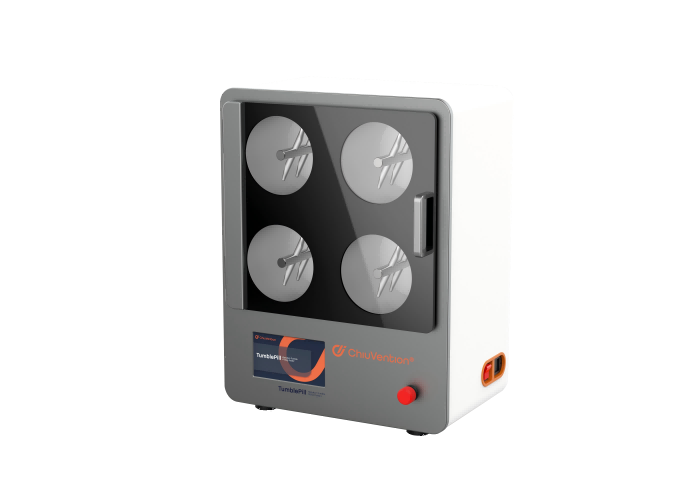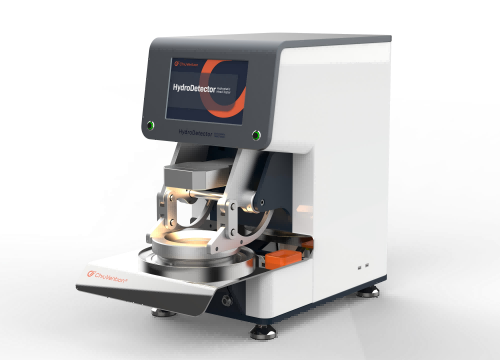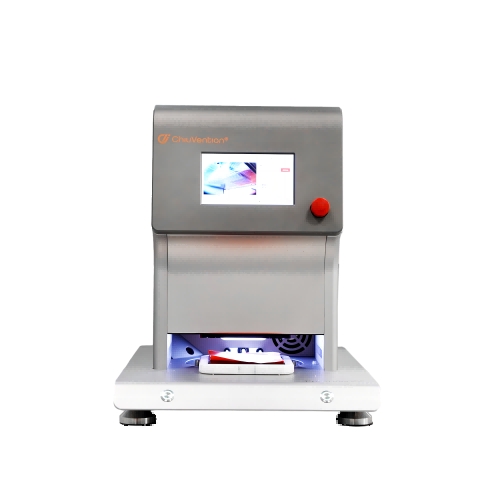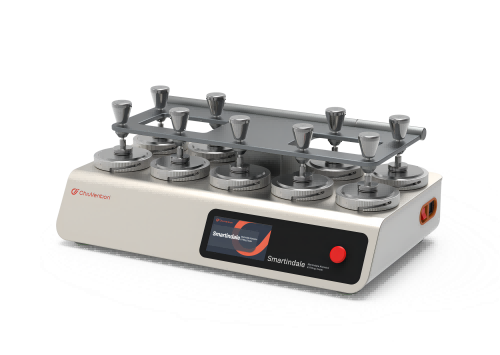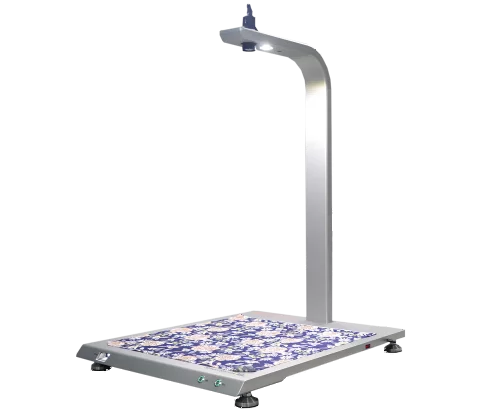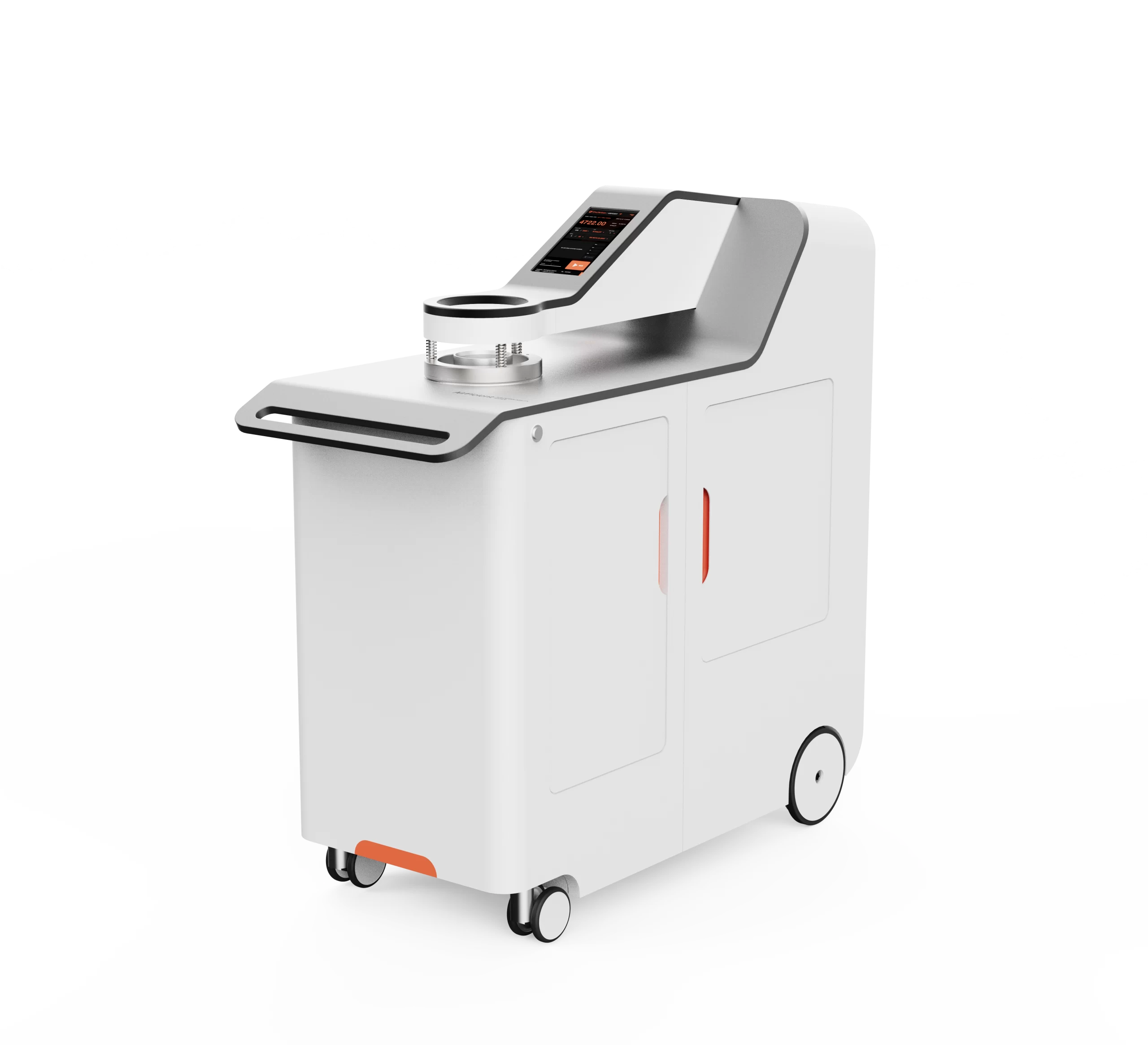Smart and faster testing
The washing fastness tester is connected via IoT to the SmarTexLab APP in the phone/PC. And the app can connect to ERP/LIMS via an API. Or, the washing fastness tester can connect directly to ERP/LIMS. There are test orders and sample information in the system, and the washing fastness tester can start the test and record the sample info, test process, and test or rating results. The system will then summarize these into a test report. The report can be sent to SmarTexLab or ERP/LIMS. The relevant parties can view the report in real-time.
Test men can monitor tests for many instruments at once. They can also change test requirements, get alerts before tests end, and stop or repeat color fastness to washing tests remotely.
In SmarTexLab, you can set up programs to start or stop the washing color fastness tester. You can chat with ChiuVention service staff for quick support. You’ll get reminders that the washing color fastness tester needs calibration, maintenance, and new consumables. Regular OTA remote upgrades are available.
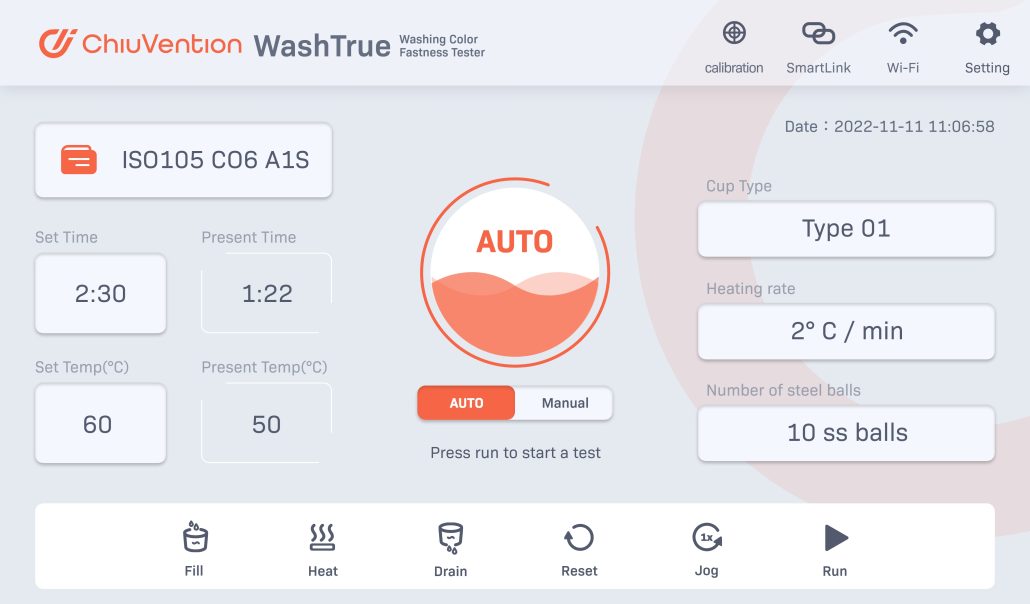
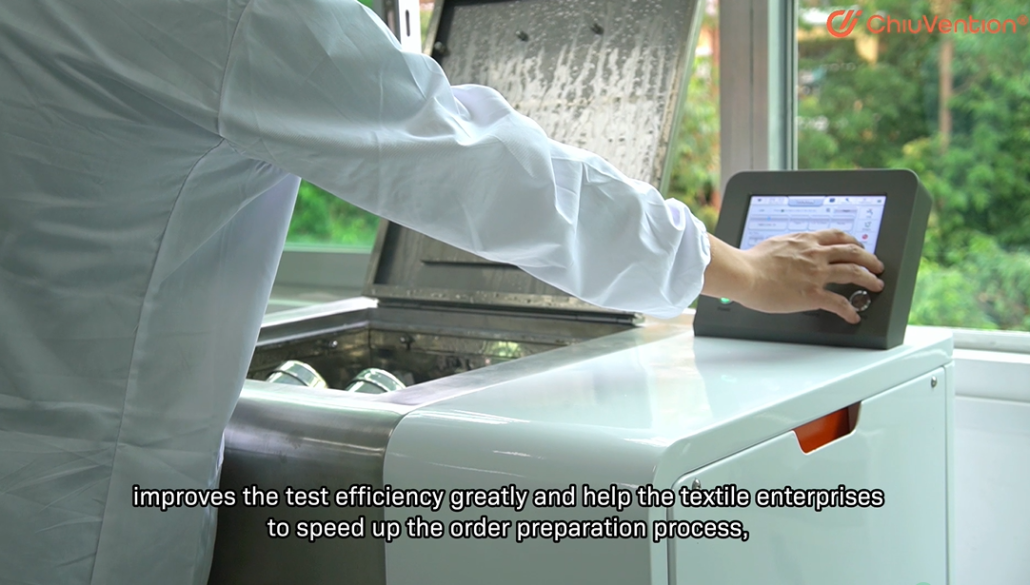
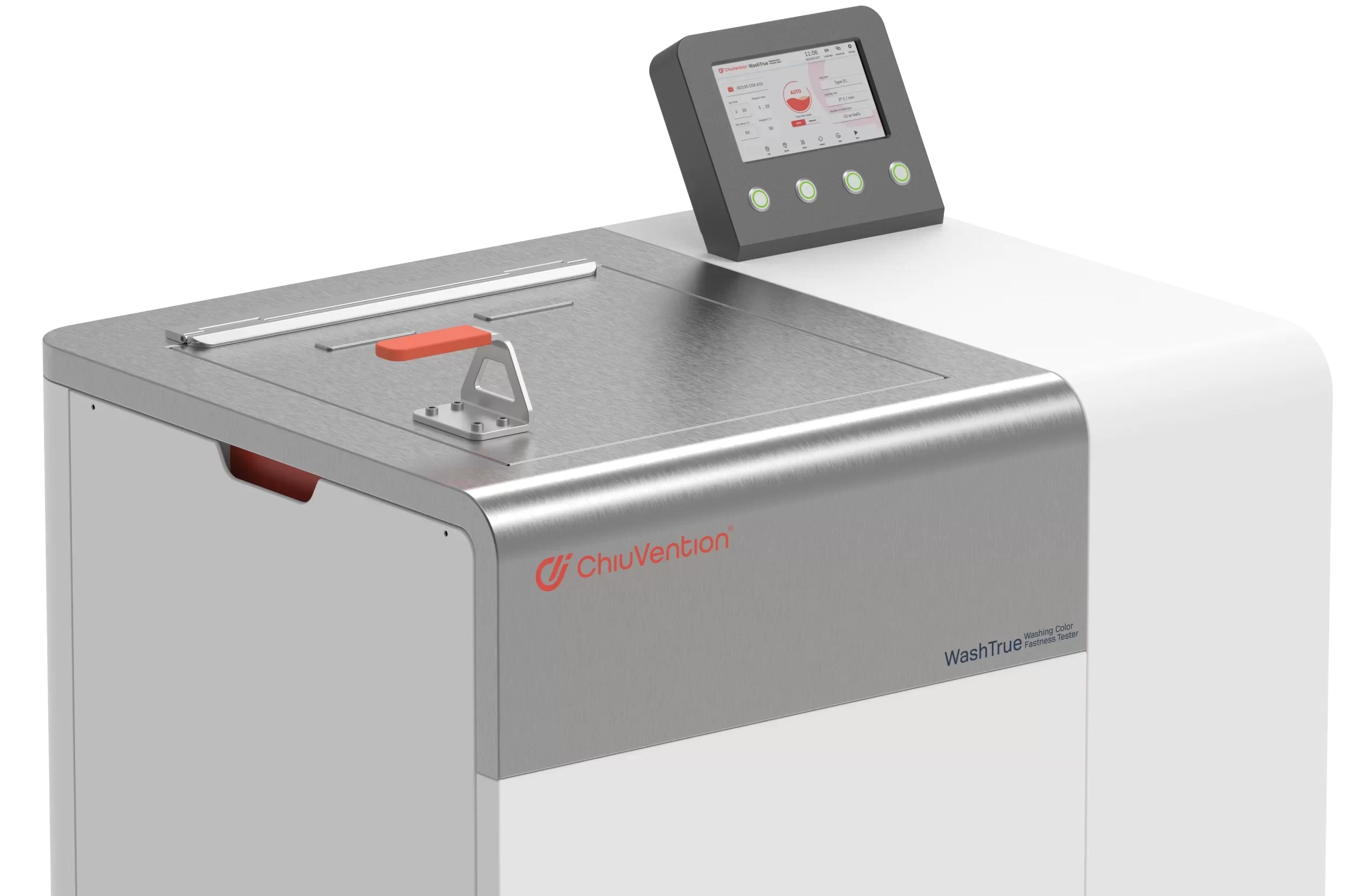
Smart, easy to use and efficient
The WashTrue Colour Fastness Tester’s smart screen lets you access many operations. You can choose color fastness to wash test standards and many settings. You can calibrate the temperature of the wash fastness test, pick a heating rate, and set the time and temperature.
Precise temperature control, more reliable testing
The WashTrue Colour Fastness Tester has a smart temperature control algorithm. It achieves accurate test water temperature control.
Humanized design, durable
Many safety designs. The test rotating frame has an anti-jamming function to protect the equipment. Controlled solid-state relays achieve the heating. They bring more stable temperature and longer life. Durable SUS304 material constructs the water tank.
Designed in Germany, quality is our life.
All our textile lab instruments are developed in-house and in cooperation with a team of renowned German industrial designers, which makes our textile lab instruments of outstanding quality. 100% source factory and factory price.
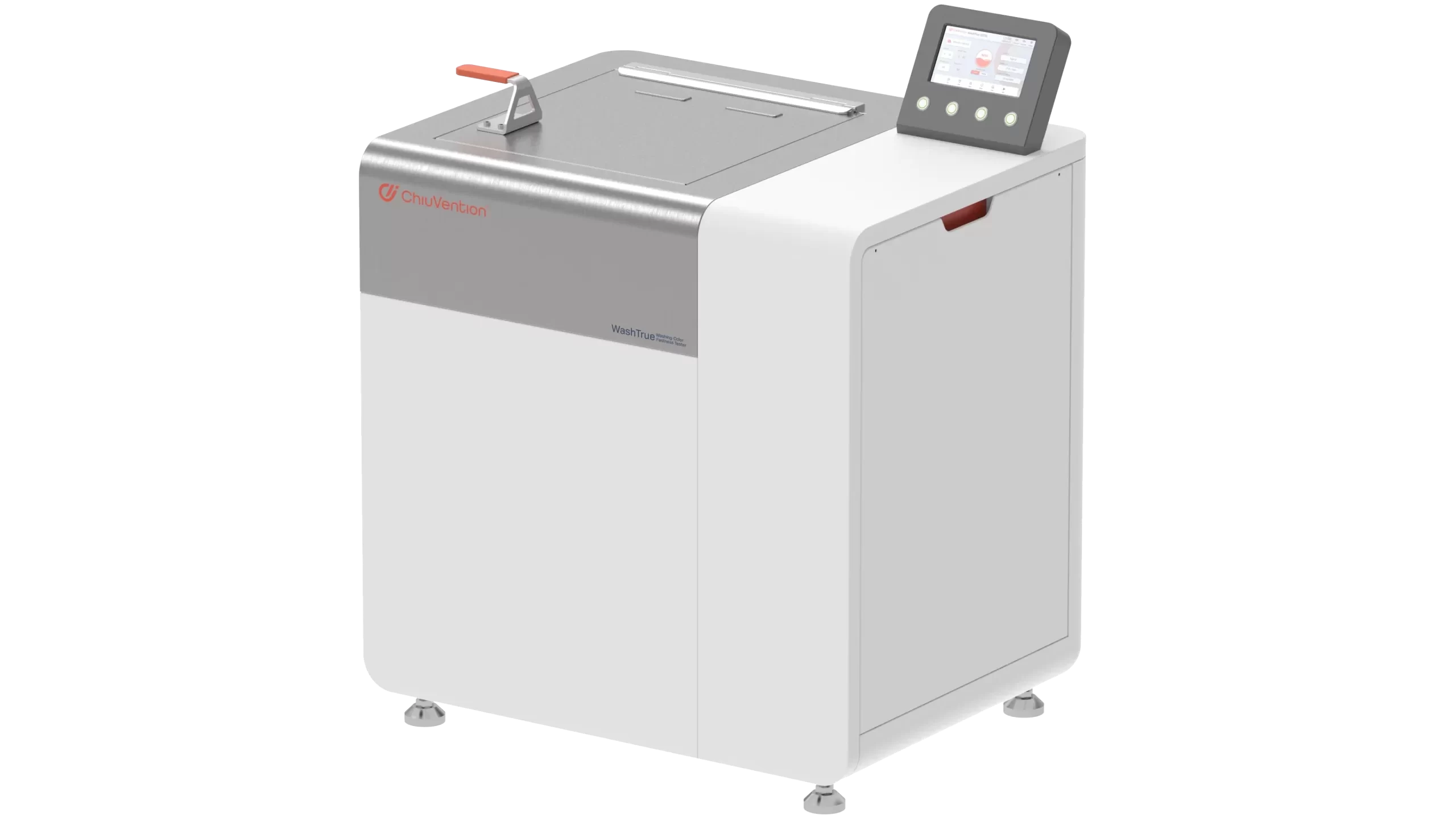
Customer Feedback
“This wash color fastness tester is easy to operate and cost-effective, and the test results are reliable.”
“We’ve been using this color fastness to wash tester for 5 months now, doing a lot of washing color fastness tests every day, and this instrument is running very stable!”
The Specification of WashTrue Colour Fastness Tester
Temperature setting range Normal temperature (>0°C)~95°C
Heating rate 1.5±0.5℃/min
Temperature accuracy ± 2°C
Speed 40 ± 2 r/min
Distance from
the bottom of the cup to the rotary axis 45±10 mm
Standard Accessories of WashTrue Washing Fastness Tester
Test steel cup 550±50mL or 1200±50mL 12 pcs
Stainless steel ball φ6±0.5mm 200pcs
Fuse 380V 32A 4pcs
Inlet pipe 1pc
Drain pipe 1pc
Tape 1pc
Screwdriver 1pc
Throat hoop 1pc
Sampling plate 40 x 100 mm
50 x 100 mm 50 x 150 mm 3pcs
Rubber gloves 1pc
ISO sealing or AATCC sealing 12 pcs
Measuring cup 100ml 1pc
Optional Accessories of WashTrue Colour Fastness Tester
Test steel cup 550±50mL 1pc
Test steel cup 1200±50mL 1pc
Stainless steel ball φ6±0.5mm 1pc
Stainless steel sheet φ30±2mm thickness 3±0.5mm 1pc
ISO color change gray card 1pc
ISO color change gray card 1pc
AATCC color change gray card 1pc
DW Multi-Fiber Cloth 50m/box 1pc
AATCC No.10 Multi-Fiber Cloth 25m/roll 1pc
Standard of WashTrue Wash Colour Fastness Tester
ISO 105 C06:2010, AATCC61-2013e3, GB/T 12490-2014,
ISO105-C08-2010,GB/T 29255-2012,ISO105-C09-2010/amd.1:2003,
GB /T 23343-2009,ISO 105 C10:2006,GB /T 3921-2008,
ISO105-E03:2010,ISO105-E12:2010,M&S C4A,
AATCC190-2010e2(2016)e2,NEXT TM 02
Optional Standard of WashTrue Colour Fastness Tester
ISO105-D01:2010
GBT 5711-2015 AATCC132-2004e3
Power
AC/220V /3N 50Hz-60Hz 40A
AC/380V/3N 50Hz-60Hz 23A Other voltages require an extemal transformer
Weight
150kg
Dimension
860*720*1060mm (W*D*H)
ChiuVention has more smart textile testing equipment. Contact us for details about textile testing machines.
OUR BROCHURE
Frequently Asked Questions
What is color fastness to washing?
Colorfastness to washing is the resistance of a textile’s color to fading or running. It refers to what happens during laundering. This is a key quality measure in textiles. It ensures that garments keep their appearance. They do not stain other items during washing. Colorfastness to washing is evaluated by subjecting the fabric to a controlled washing process. Then, the degree of color change and staining is assessed.
What is the color fastness to washing test methods?
The washing fastness test rates how well a fabric’s color holds up to washing. Here’s a detailed breakdown of a standard test method. It follows the ISO 105-C06 or AATCC 61 standards.
Color Fastness to Washing Test Method Overview
-
Sample Preparation:
-
Cut the fabric sample to a specified size, typically 10 cm x 4 cm.
-
Attach the fabric sample to an adjacent fabric. This fabric is often a multi-fiber strip. It includes fibers like cotton, wool, nylon, polyester, acrylic, and acetate.
-
Washing Solution:
-
Prepare the washing solution according to the specified standard. This usually includes a standard detergent and sometimes additional chemicals like sodium perborate.
-
The color fastness to the washing test standard defines the concentration and composition of the washing solution.
-
Washing Procedure:
-
Place the sample and the multi-fiber strip in a washing container. This could be a launder-o-meter or a similar device that simulates home or industrial laundering.
-
Add the washing solution to the container.
-
Set the Rotawash machine to the specified temperature and agitation settings. Common conditions might include:
-
ISO 105-C06: Washing at 40°C or 60°C for a set duration with specified mechanical agitation.
-
AATCC 61: Washing at 49°C (120°F) or 60°C (140°F) for 45 minutes with mechanical agitation.
-
Rinsing and Drying:
-
After washing, rinse the samples thoroughly in water to remove any residual detergent.
-
Dry the samples according to the Color Fastness to Washing Test Standard, usually air drying or specified machine drying conditions.
-
Assessment:
-
Color Change: Compare the washed fabric sample against an unwashed control sample. Use a grey scale for color change to rate the degree of fading.
-
Staining: Assess the adjacent fabric (multi-fiber strip) for staining. Use a grey scale for staining to evaluate the degree of color transfer.
Rating Scales
-
Grey Scale for Color Change: This scale ranges from 1 to 5, where:
-
5 = No change (excellent fastness)
-
4 = Slight change
-
3 = Noticeable change
-
2 = Significant change
-
1 = Severe change (poor fastness)
-
Grey Scale for Staining: This scale also ranges from 1 to 5, where:
-
5 = No staining (excellent fastness)
-
4 = Slight staining
-
3 = Noticeable staining
-
2 = Significant staining
-
1 = Severe staining (poor fastness)
What's the color fastness to washing standards?
The standards measure color fastness to washing. They evaluate how well a textile’s color withstands washing. These standards ensure consistency and reliability in testing across different laboratories and manufacturers. Here are some of the most commonly used standards:
ISO Standards
ISO 105-C06
This is one of the most widely recognized international standards. It assesses color fastness to washing. The ISO 105-C06 standard includes several test procedures. Each is for different washing conditions.
-
ISO 105-C06 A1S: Washing at 40°C with soap.
-
ISO 105-C06 B2S: Washing at 50°C with soap and soda.
-
ISO 105-C06 C2S: Washing at 60°C with soap and soda.
The Color Fastness to Washing Test Standard covers three things. It covers the preparation of samples, washing procedures, and the evaluation of Color Fastness to Washing Rating, color change, and staining using grey scales.
AATCC Standards
AATCC 61
This Color Fastness to Washing Test Standard is widely used in North America. It specifies test methods for colorfastness to laundering. The tests typically simulate five home or commercial launderings.
-
AATCC 61-1A: Laundering at 49°C (120°F) for 45 minutes.
-
AATCC 61-2A: Laundering at 49°C (120°F) for 45 minutes with a higher concentration of detergent.
-
AATCC 61-3A: Laundering at 60°C (140°F) for 45 minutes.
These Color Fastness to Washing Test Methods have set conditions for washing, rinsing, and drying. The results are evaluated using grey scales for color change and staining.
JIS Standards
JIS L0844
The Japanese Industrial Standards (JIS) provide methods for testing color fastness to washing:
-
JIS L0844 specifies washing at different temperatures and conditions. This is similar to ISO and AATCC methods.
BS Standards
BS EN ISO 105-C06
The British Standards Institution (BSI) adopts the ISO 105-C06 standard. This aligns UK practices with international testing methods.
Key Elements of These Standards
-
Sample Preparation: All standards specify the size and prep of textile samples. They also specify the prep of the adjacent fabrics (multi-fiber strips).
-
Washing Conditions: Detailed conditions for temperature, detergent composition, mechanical agitation, and duration.
-
Rinsing and Drying: Procedures for rinsing and drying samples after washing.
-
Assessment: Use grey scales to evaluate color change and staining on nearby fabrics.
Grey Scales
-
Grey Scale for Color Change: Measures the degree of fading, with ratings from 1 (severe change) to 5 (no change).
-
The Grey Scale for Staining measures color transfer. Ratings range from 1 (severe) to 5 (none).
Importance of Adhering to Standards
Following these Color Fastness to Washing Test Standards ensures that textile products are tested consistently. They provide reliable data on how the products perform during laundering. This is crucial for manufacturers, retailers, and consumers, ensuring product quality and longevity.
Conclusion
They can use standards like ISO 105-C06, AATCC 61, JIS L0844, and BS EN ISO 105-C06. These let labs and makers check and promise the color fastness of textiles to washing. This ensures high-quality products that meet consumer expectations.
What are the differences between single cylinder model and dual cylinder model ?
- Single-cylinder models:
- Characteristics: Single-cylinder color fastness to washing testers usually have one cylinder and can test a small number of samples at the same time. It is suitable for smaller batch testing or basic laboratory testing needs.
- Scenarios: The single-cylinder models are suitable for handling smaller laboratory tests or for use in a low frequency testing environment. For users with small sample sizes and infrequent testing, the single-cylinder tester can meet basic washing color fastness testing requirements.
- Dual Cylinder Model:
- Characteristics: The double-cylinder tester, on the other hand, is equipped with two independent cylinders and can perform two sets of tests simultaneously, which can significantly improve color fastness to washing testing efficiency. Usually, two groups of samples can be tested under different test conditions (e.g. different temperatures, different times, different soaps or reagents).
- Applicable scenarios: The dual-cylinder model is suitable for users who have a high frequency of testing or need to test multiple batches of samples at the same time. Especially for laboratories or factories that handle a large number of samples or need to obtain multiple sets of color fastness to wash test results quickly, the Dual Cylinder model can increase productivity.
What is the Washing Color Fastness Tester ?
The Color Fastness to Washing Tester is a lab instrument. Textile materials use it to test how well they keep their color during washing. One can measure how much color fades or bleeds. Fabrics or clothes can experience this when washed many times.
The Washing Fastness Tester has a stainless steel container. Water and detergent fill it. The textile sample is a fabric swatch or a garment piece. To mimic real washing conditions, place it inside a mesh bag or a basket. The bag or basket contains the sample. It stops it from touching the agitator or other machine parts.
In the Wash Fastness Test, the tester agitates the water and detergent. It simulates the action of a washing machine. This agitation causes the fabric to rub against itself and other surfaces. This rubbing can lead to color loss or transfer. The washing process can use different temperatures, cycle lengths, and agitation modes. These simulate various washing conditions.
After washing, someone takes out the sample. Someone checks for color changes. We test the colorfastness by comparing the sample’s color before and after washing. You can do this assessment. Or, you can use instruments like spectrophotometers to get aim color data.
The Colour Fastness Tester is common in textile and garment industries. It tests whether the fabrics and garments keep their color. They should not fade or bleed during repeated washing. The test results can guide manufacturers. They can help in choosing dyes, finishes, and laundering methods. These choices can boost the colorfastness of their products.
How does the WashTrue Colour Fastness Tester work?
The Rotawash Color Fastness to Washing Tester simulates washing’s effect on fabric color. In the testing chamber, researchers mount fabric samples onto steel holders. They mimic a washing machine’s conditions. The chamber fills with water and detergent, replicating laundry cycles. Fabric samples undergo agitation and friction during washing, simulating mechanical stresses. After cycles, standardized color size techniques check color changes. The Colour Fastness Tester gives a reliable method for testing material color fastness. It ensures that textiles meet quality requirements over the years.
What varieties of fabric may be examined using the WashTrue Colour Fastness Tester?
The WashTrue Washing Fastness Tester comprises many fabrics, including cotton, polyester, wool, nylon, and blends. It is suitable for testing textiles in clothes, upholstery, and business programs. With its versatility, the Color Fastness to Washing Tester can simulate diverse washing situations, temperatures, detergent formulations, and agitation levels. This flexibility allows for comprehensive testing, ensuring fabric performance aligns with real-globe laundering eventualities.
How can the results from the WashTrue Washing Color Fastness Tester be interpreted?
The WashTrue Color Fastness to Wash Tester gives color fastness results. We interpret them by analyzing color change. They look at transfer after washing. Standardized criteria established by regulatory bodies or industry businesses guide result interpretation. Little color change and transfer suggest good color fastness. But, big adjustments may mean dye went in or the fabric has issues. Interpretation considers elements like fabric composition, dye kind, and intended use. Results inform choices on product labels, advisories, and quality rules. They ensure the making of long-lasting, colorfast textiles. For more about the color fastness of washing test machines, contact ChiuVention. We are a textile testing machine maker with rich testing knowledge.
What are the specifications available in the WashTrue Washing Fastness Tester?
The WashTrue Color Fastness to Washing Tester is a complicated device. The test measures how well fabrics keep their color after many washings. Underneath are the special specifications of this testing device:
-
Temperature Settings and Heating Rate
Temperature setting range: Regular temperature (>0°C) to 95°C
Heating rate: 1.5±0.5℃/min
Temperature accuracy: ± 2°C
The Washing Fastness Tester allows unique control over wash temperature. This ensures regular and reliable test results.
-
-
Speed and Distance
Speed: 40 ± 2 r/min
Distance from the lowest of the cup to the rotary axis: 45±10 mm
These parameters determine the agitation and stress on the fabric samples during washing. They replicate real-world laundering conditions.
-
Popular accessories:
Test steel cup: 550±50mL or 1200±50mL (12 pcs)
Stainless steel ball: φ6±zero.5mm (2oo pcs)
Fuse: 380V 32A (4 pcs)
Inlet pipe: 1 pc
Drain pipe: 1 pc
Tape: 1 pc
Screwdriver: 1 pc
Throat hoop: 1 pc
Sampling plate: 40 x 100 mm, 50 x 100 mm, 50 x 150 mm (3 pcs)
Rubber gloves: 1 pc
ISO sealing or AATCC sealing: 12 pcs
Measuring cup: 100ml (1 pc)
These accessories make the test easier. They ensure that results are correct and standard. The results must follow the established testing protocols.
Requirements Supported
The WashTrue Washing color Fastness Tester conforms to many worldwide standards. It conforms to the following:
ISO 105 C06:2010
AATCC61-2013e3
GB/T 12490-2014
ISO105-C08-2010
GB/T 29255-2012
ISO105-C09-2010/amd.1:2003
GB /T 23343-2009
ISO 105 C10:2006
GB /T 3921-2008
ISO105-E03:2010
ISO105-E12:2010
M&S C4A
AATCC190-2010e2(2016)e2
NEXT TM 02
The requirements ensure that the color fastness to washing meets industry needs. It also meets quality benchmarks.
How user-friendly is the smart screen interface of the Colour Fastness to Washing Tester?
The Color Fastness to Washing Tester has a smart screen. Operators can navigate using many operations. These tasks include choosing test needs. They also include setting custom options. You can set the temperature, the heating rate, choose the type of test cup, the test standard, the number of steel balls, etc.
And this GyroWash color fastness to washing tester has the IoT function, you can complete all the settings as well as monitor the whole Color Fastness to Washing Testing process on your smartphone, which is very convenient and efficient.
How does the smart interface contribute to the performance of the color Fastness to Washing Tester?
The Color Fastness to Wash Tester’s smart interface boosts efficiency. It allows quick access to many operations and parameters. Operators can select test requirements, parameters, and temperatures. They can streamline tests, saving time and resources. This efficiency empowers users. The simple interface minimizes complexity. It ensures smooth user testing reviews across many types of programs and industries.
How does the best temperature control function improve testing reliability with the color fastness to wash tester?
The Washing Fastness Tester has a smart temperature control algorithm. It ensures the precise and powerful law of test water temperature. This option enhances testing reliability. It does this by keeping steady and accurate temperatures throughout the Color Fastness to Washing Test. Operators can rely on the Washing Fastness Tester. It provides solid conditions, reducing variability and ensuring reproducible effects. The precise temperature control feature is key. It helps ensure reliable test results. This makes the Washing Fastness Tester a trusted tool for quality assessment. Textile and fabric industries use it for research.
What factors of the Washing Color Fastness Tester's design make it long-lasting and user-friendly?
The Washing Color Fastness Tester has a human touch. It has functions that make it strong and easy to use. One function is smart temperature management. It is a set of rules that guarantees precise temperature control. It also boosts the equipment’s durability. The Washing Color Fastness Tester minimizes wear and tear. It does this by keeping the best operating conditions. This prolongs its life and cuts maintenance needs. Also, its user-friendly layout complements usability. It makes it intuitive and handy for operators. The sturdiness and user-centric format make the Washing Color Fastness Tester reliable. It is also efficient for fabric Color Fastness to Washing Test.
Colorfastness to washing is the resistance of a textile’s color to fading or running. It refers to what happens during laundering. This is a key quality measure in textiles. It ensures that garments keep their appearance. They do not stain other items during washing. Colorfastness to washing is evaluated by subjecting the fabric to a controlled washing process. Then, the degree of color change and staining is assessed.
The washing fastness test rates how well a fabric’s color holds up to washing. Here’s a detailed breakdown of a standard test method. It follows the ISO 105-C06 or AATCC 61 standards.
Color Fastness to Washing Test Method Overview
-
Sample Preparation:
-
Cut the fabric sample to a specified size, typically 10 cm x 4 cm.
-
Attach the fabric sample to an adjacent fabric. This fabric is often a multi-fiber strip. It includes fibers like cotton, wool, nylon, polyester, acrylic, and acetate.
-
-
Washing Solution:
-
Prepare the washing solution according to the specified standard. This usually includes a standard detergent and sometimes additional chemicals like sodium perborate.
-
The color fastness to the washing test standard defines the concentration and composition of the washing solution.
-
-
Washing Procedure:
-
Place the sample and the multi-fiber strip in a washing container. This could be a launder-o-meter or a similar device that simulates home or industrial laundering.
-
Add the washing solution to the container.
-
Set the Rotawash machine to the specified temperature and agitation settings. Common conditions might include:
-
ISO 105-C06: Washing at 40°C or 60°C for a set duration with specified mechanical agitation.
-
AATCC 61: Washing at 49°C (120°F) or 60°C (140°F) for 45 minutes with mechanical agitation.
-
-
-
Rinsing and Drying:
-
After washing, rinse the samples thoroughly in water to remove any residual detergent.
-
Dry the samples according to the Color Fastness to Washing Test Standard, usually air drying or specified machine drying conditions.
-
-
Assessment:
-
Color Change: Compare the washed fabric sample against an unwashed control sample. Use a grey scale for color change to rate the degree of fading.
-
Staining: Assess the adjacent fabric (multi-fiber strip) for staining. Use a grey scale for staining to evaluate the degree of color transfer.
-
Rating Scales
-
Grey Scale for Color Change: This scale ranges from 1 to 5, where:
-
5 = No change (excellent fastness)
-
4 = Slight change
-
3 = Noticeable change
-
2 = Significant change
-
1 = Severe change (poor fastness)
-
-
Grey Scale for Staining: This scale also ranges from 1 to 5, where:
-
5 = No staining (excellent fastness)
-
4 = Slight staining
-
3 = Noticeable staining
-
2 = Significant staining
-
1 = Severe staining (poor fastness)
-
The standards measure color fastness to washing. They evaluate how well a textile’s color withstands washing. These standards ensure consistency and reliability in testing across different laboratories and manufacturers. Here are some of the most commonly used standards:
ISO Standards
ISO 105-C06
This is one of the most widely recognized international standards. It assesses color fastness to washing. The ISO 105-C06 standard includes several test procedures. Each is for different washing conditions.
-
ISO 105-C06 A1S: Washing at 40°C with soap.
-
ISO 105-C06 B2S: Washing at 50°C with soap and soda.
-
ISO 105-C06 C2S: Washing at 60°C with soap and soda.
The Color Fastness to Washing Test Standard covers three things. It covers the preparation of samples, washing procedures, and the evaluation of Color Fastness to Washing Rating, color change, and staining using grey scales.
AATCC Standards
AATCC 61
This Color Fastness to Washing Test Standard is widely used in North America. It specifies test methods for colorfastness to laundering. The tests typically simulate five home or commercial launderings.
-
AATCC 61-1A: Laundering at 49°C (120°F) for 45 minutes.
-
AATCC 61-2A: Laundering at 49°C (120°F) for 45 minutes with a higher concentration of detergent.
-
AATCC 61-3A: Laundering at 60°C (140°F) for 45 minutes.
These Color Fastness to Washing Test Methods have set conditions for washing, rinsing, and drying. The results are evaluated using grey scales for color change and staining.
JIS Standards
JIS L0844
The Japanese Industrial Standards (JIS) provide methods for testing color fastness to washing:
-
JIS L0844 specifies washing at different temperatures and conditions. This is similar to ISO and AATCC methods.
BS Standards
BS EN ISO 105-C06
The British Standards Institution (BSI) adopts the ISO 105-C06 standard. This aligns UK practices with international testing methods.
Key Elements of These Standards
-
Sample Preparation: All standards specify the size and prep of textile samples. They also specify the prep of the adjacent fabrics (multi-fiber strips).
-
Washing Conditions: Detailed conditions for temperature, detergent composition, mechanical agitation, and duration.
-
Rinsing and Drying: Procedures for rinsing and drying samples after washing.
-
Assessment: Use grey scales to evaluate color change and staining on nearby fabrics.
Grey Scales
-
Grey Scale for Color Change: Measures the degree of fading, with ratings from 1 (severe change) to 5 (no change).
-
The Grey Scale for Staining measures color transfer. Ratings range from 1 (severe) to 5 (none).
Importance of Adhering to Standards
Following these Color Fastness to Washing Test Standards ensures that textile products are tested consistently. They provide reliable data on how the products perform during laundering. This is crucial for manufacturers, retailers, and consumers, ensuring product quality and longevity.
Conclusion
They can use standards like ISO 105-C06, AATCC 61, JIS L0844, and BS EN ISO 105-C06. These let labs and makers check and promise the color fastness of textiles to washing. This ensures high-quality products that meet consumer expectations.
- Single-cylinder models:
- Characteristics: Single-cylinder color fastness to washing testers usually have one cylinder and can test a small number of samples at the same time. It is suitable for smaller batch testing or basic laboratory testing needs.
- Scenarios: The single-cylinder models are suitable for handling smaller laboratory tests or for use in a low frequency testing environment. For users with small sample sizes and infrequent testing, the single-cylinder tester can meet basic washing color fastness testing requirements.
- Dual Cylinder Model:
- Characteristics: The double-cylinder tester, on the other hand, is equipped with two independent cylinders and can perform two sets of tests simultaneously, which can significantly improve color fastness to washing testing efficiency. Usually, two groups of samples can be tested under different test conditions (e.g. different temperatures, different times, different soaps or reagents).
- Applicable scenarios: The dual-cylinder model is suitable for users who have a high frequency of testing or need to test multiple batches of samples at the same time. Especially for laboratories or factories that handle a large number of samples or need to obtain multiple sets of color fastness to wash test results quickly, the Dual Cylinder model can increase productivity.
The Color Fastness to Washing Tester is a lab instrument. Textile materials use it to test how well they keep their color during washing. One can measure how much color fades or bleeds. Fabrics or clothes can experience this when washed many times.
The Washing Fastness Tester has a stainless steel container. Water and detergent fill it. The textile sample is a fabric swatch or a garment piece. To mimic real washing conditions, place it inside a mesh bag or a basket. The bag or basket contains the sample. It stops it from touching the agitator or other machine parts.
In the Wash Fastness Test, the tester agitates the water and detergent. It simulates the action of a washing machine. This agitation causes the fabric to rub against itself and other surfaces. This rubbing can lead to color loss or transfer. The washing process can use different temperatures, cycle lengths, and agitation modes. These simulate various washing conditions.
After washing, someone takes out the sample. Someone checks for color changes. We test the colorfastness by comparing the sample’s color before and after washing. You can do this assessment. Or, you can use instruments like spectrophotometers to get aim color data.
The Colour Fastness Tester is common in textile and garment industries. It tests whether the fabrics and garments keep their color. They should not fade or bleed during repeated washing. The test results can guide manufacturers. They can help in choosing dyes, finishes, and laundering methods. These choices can boost the colorfastness of their products.
The Rotawash Color Fastness to Washing Tester simulates washing’s effect on fabric color. In the testing chamber, researchers mount fabric samples onto steel holders. They mimic a washing machine’s conditions. The chamber fills with water and detergent, replicating laundry cycles. Fabric samples undergo agitation and friction during washing, simulating mechanical stresses. After cycles, standardized color size techniques check color changes. The Colour Fastness Tester gives a reliable method for testing material color fastness. It ensures that textiles meet quality requirements over the years.
The WashTrue Washing Fastness Tester comprises many fabrics, including cotton, polyester, wool, nylon, and blends. It is suitable for testing textiles in clothes, upholstery, and business programs. With its versatility, the Color Fastness to Washing Tester can simulate diverse washing situations, temperatures, detergent formulations, and agitation levels. This flexibility allows for comprehensive testing, ensuring fabric performance aligns with real-globe laundering eventualities.
The WashTrue Color Fastness to Wash Tester gives color fastness results. We interpret them by analyzing color change. They look at transfer after washing. Standardized criteria established by regulatory bodies or industry businesses guide result interpretation. Little color change and transfer suggest good color fastness. But, big adjustments may mean dye went in or the fabric has issues. Interpretation considers elements like fabric composition, dye kind, and intended use. Results inform choices on product labels, advisories, and quality rules. They ensure the making of long-lasting, colorfast textiles. For more about the color fastness of washing test machines, contact ChiuVention. We are a textile testing machine maker with rich testing knowledge.
The WashTrue Color Fastness to Washing Tester is a complicated device. The test measures how well fabrics keep their color after many washings. Underneath are the special specifications of this testing device:
-
Temperature Settings and Heating Rate
Temperature setting range: Regular temperature (>0°C) to 95°C
Heating rate: 1.5±0.5℃/min
Temperature accuracy: ± 2°C
The Washing Fastness Tester allows unique control over wash temperature. This ensures regular and reliable test results.
-
-
Speed and Distance
Speed: 40 ± 2 r/min
Distance from the lowest of the cup to the rotary axis: 45±10 mm
These parameters determine the agitation and stress on the fabric samples during washing. They replicate real-world laundering conditions.
-
Popular accessories:
Test steel cup: 550±50mL or 1200±50mL (12 pcs)
Stainless steel ball: φ6±zero.5mm (2oo pcs)
Fuse: 380V 32A (4 pcs)
Inlet pipe: 1 pc
Drain pipe: 1 pc
Tape: 1 pc
Screwdriver: 1 pc
Throat hoop: 1 pc
Sampling plate: 40 x 100 mm, 50 x 100 mm, 50 x 150 mm (3 pcs)
Rubber gloves: 1 pc
ISO sealing or AATCC sealing: 12 pcs
Measuring cup: 100ml (1 pc)
These accessories make the test easier. They ensure that results are correct and standard. The results must follow the established testing protocols.
-
The WashTrue Washing color Fastness Tester conforms to many worldwide standards. It conforms to the following:
ISO 105 C06:2010
AATCC61-2013e3
GB/T 12490-2014
ISO105-C08-2010
GB/T 29255-2012
ISO105-C09-2010/amd.1:2003
GB /T 23343-2009
ISO 105 C10:2006
GB /T 3921-2008
ISO105-E03:2010
ISO105-E12:2010
M&S C4A
AATCC190-2010e2(2016)e2
NEXT TM 02
The requirements ensure that the color fastness to washing meets industry needs. It also meets quality benchmarks.
The Color Fastness to Washing Tester has a smart screen. Operators can navigate using many operations. These tasks include choosing test needs. They also include setting custom options. You can set the temperature, the heating rate, choose the type of test cup, the test standard, the number of steel balls, etc.
And this GyroWash color fastness to washing tester has the IoT function, you can complete all the settings as well as monitor the whole Color Fastness to Washing Testing process on your smartphone, which is very convenient and efficient.
The Color Fastness to Wash Tester’s smart interface boosts efficiency. It allows quick access to many operations and parameters. Operators can select test requirements, parameters, and temperatures. They can streamline tests, saving time and resources. This efficiency empowers users. The simple interface minimizes complexity. It ensures smooth user testing reviews across many types of programs and industries.
The Washing Fastness Tester has a smart temperature control algorithm. It ensures the precise and powerful law of test water temperature. This option enhances testing reliability. It does this by keeping steady and accurate temperatures throughout the Color Fastness to Washing Test. Operators can rely on the Washing Fastness Tester. It provides solid conditions, reducing variability and ensuring reproducible effects. The precise temperature control feature is key. It helps ensure reliable test results. This makes the Washing Fastness Tester a trusted tool for quality assessment. Textile and fabric industries use it for research.
The Washing Color Fastness Tester has a human touch. It has functions that make it strong and easy to use. One function is smart temperature management. It is a set of rules that guarantees precise temperature control. It also boosts the equipment’s durability. The Washing Color Fastness Tester minimizes wear and tear. It does this by keeping the best operating conditions. This prolongs its life and cuts maintenance needs. Also, its user-friendly layout complements usability. It makes it intuitive and handy for operators. The sturdiness and user-centric format make the Washing Color Fastness Tester reliable. It is also efficient for fabric Color Fastness to Washing Test.
A color fastness to wash tester measures how well a fabric keeps its color. It does this when subjected to washing.
This tester works by simulating washing conditions at home or in a store. It does this to find out how much color loss and staining occurs on other fabrics.
Here’s a breakdown of the working principle:
-
Sample Preparation:
-
We cut fabric samples to a specific size for testing.
-
These samples are often sewn to a multi-fiber strip. Evaluating staining on different fibers is the purpose of this process.
-
-
Detergent and Solution Preparation:
-
We prepare a standard detergent solution. We follow specific guidelines, such as ISO and AATCC standards.
-
-
Loading the Tester:
-
The prepared fabric samples go in the containers with the multi-fiber strips.
-
The containers are then filled with the detergent solution.
-
-
Washing Cycle:
-
The containers are placed in the tester. It rotates them at a set speed and temperature for a certain time. This mimics the washing’s mechanical and thermal actions.
-
The temperature, agitation speed, and time are controlled to simulate real washing conditions.
-
- Rinsing and drying:
-
After the wash, rinse the samples well to remove any detergent.
-
The samples are then dried under controlled conditions.
-
-
Assessment:
-
We evaluate the washed samples for color change. We use a gray scale or spectrophotometer to measure the degree of color loss.
-
The team also assesses the multi-fiber strips. They do this to see how much staining transfers from the tested fabric to other fibers.
-
-
Rating:
-
Rate the results on standardized scales. These scales include ISO or AATCC grading scales. They give a number that shows the fabric’s color fastness to washing.
-
By following these steps, the wash tester assesses color fastness. It provides a standard way to see how well a fabric’s color lasts after washing. This helps manufacturers ensure their products are good quality and last a long time.
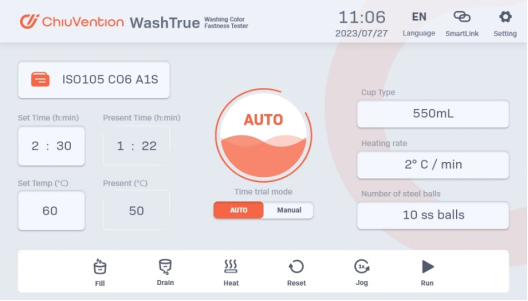
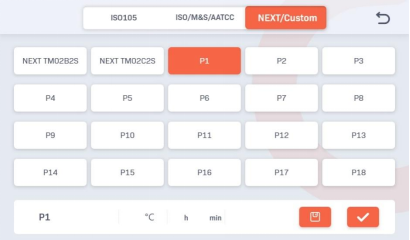
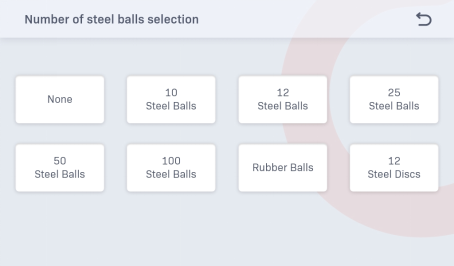
For detailed instructions of machine operation, you can contact us for the Manual, here is a brief introduction.
The above is the operation screen and you can check the series of buttons with different functions. Such as test standard selection, temperature set and time set, heating rate and test cup size, etc.
The main steps are as follows:
Standard program test routines
This routine demonstrates the use of the left-cylinder. It’s for washing color fastness testing to ISO105 C06 A1S.
Preparation
Place the test garment in the cup along with the steel ball.
Install the large test cup and the small one on the main shaft of the water cylinder.
Please make sure that no one is installing the test cups or sticking their hands into the left and right cylinders before rotating the test cup clamps during the installation process.
Check whether the inlet hose and the drain hose are installed well.
Water Filling
Click on the “Fill” button to ensure that the water level in the tank is properly appropriate.
Standard Selection
Click and enter the standard selection interface, and choose related test standards.
Start Test
Click to start the test.
Test Completion
When the buzzer alarms, remove the laundry from the cup. Click “Drain” to discharge the water, but only if its temperature is below 70 degrees.
This interface has five points for calibrating the temperature curve. Each point is a five-degree interval above 10 ℃. They let the user select and set the temperature. Click on the start button to start stirring and heating. The water heats to the calibration temperature. The operation is suspended. You set the current calibration by entering the measured temperature.
Calibration Steps:
Step 1: Click on “Select Temperature” and set the first temperature point that you want to heat. Then click “Start” to heat it to that temperature.
Step 2: Press “Pause” when the temperature gets near the desired point.
Step 3: Enter the measured water temperature into the first “Measured Temperature.” This completes the calibration of the first point. Then, set the remaining four temperature points to finish the whole curve’s calibration.
Step 4: save the calibration.
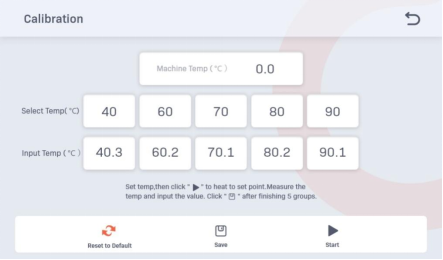
Maintenance
-
Regular Cleaning:
-
Clean it daily. Use a soft, damp cloth to wipe off the inside and outside. This removes detergent and fabric.
-
Clean the containers, lids, and any removable parts well each week. This prevents buildup of detergent and fabric residues.
-
-
Inspection:
-
Check daily for wear or damage. This includes cracks in containers or loose parts.
-
Inspect monthly. Look closely at all mechanical parts. This includes the rotating mechanism, seals, and gaskets. Look for any signs of wear and tear.
-
-
Lubrication:
-
Lubricate moving parts, like hinges and rotating mechanisms, per the maker’s guidelines. This keeps them working smoothly.
-
-
Calibration:
-
Set temperature control, rotation speed, and timers to match specifications. This may require specialized equipment or professional services.
-
-
Software Updates:
-
If the tester has a digital interface, ensure that the software is up to date. Check for any firmware updates from the manufacturer.
-
Repair
-
Troubleshooting Common Issues:
-
Inconsistent Rotation: Check and tighten any loose belts or gears. Replace worn-out components.
-
Temperature Fluctuations: Inspect and replace faulty heating elements or temperature sensors.
-
Leakage: Check seals and gaskets for wear and replace as necessary. Ensure that containers are properly secured.
-
-
Replacing Parts:
-
Containers and Lids: Replace any cracked or damaged containers and lids.
-
Heating Elements: Replace faulty heating elements following the manufacturer’s instructions.
-
Replace any broken electronic parts, like timers or controllers. Use genuine parts from the manufacturer.
-
-
Professional Servicing:
-
Schedule regular servicing with a qualified technician. Do this especially for complex repairs or if the tester is heavily used.
-
Keep a record of all maintenance and repairs performed for future reference.
-
-
Spare Parts Inventory:
-
Keep an inventory of key spare parts. These include seals, gaskets, heating elements, and electronic parts. This cuts downtime during repairs.
-
-
Manufacturer Support:
-
Contact ChiuVention for technical support, replacement parts, and service recommendations.
-

